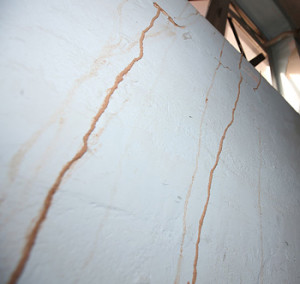Why Do Termites Make Mud Tubes?
By Chris Williams on March 31, 2015.

Termite tubes running up a basement wall.
Not all termites make mud tubes, but our subterranean termites do. That’s because they are vulnerable with soft bodies (no external cuticle for protection). Termites nest in the ground but travel away from the nest to find the wood that they feed on. As long as they are moving through the soil they are fine, but they require protection if they must travel above ground. The moist mud tubes protect them from predators and keep their bodies from drying out when exposed to air.
The tubes are made of soil, maybe mixed with wood particles, that the termites plaster together using a glue-like secretion from their mouths. Fecal material (termite “poop”) is also used as cement. Termites plaster the mixture onto a surface and keep adding more until they have a completed, connected, covered tube. The termites then safely move within the tubes to travel between their nest and their food source. Most tubes are less than 12 inches long.
A Tube for Every Purpose
Termites even have specialized mud tubes for different purposes: exploratory tubes, working tubes, drop tubes, free-standing tubes, and swarming tubes (see What Do Termite Tubes Look Like?). Drop tubes are suspended from an upper wood support towards the ground, but are not attached at any other point. Free-standing tubes are similar but are built from the ground up to wood. Working tubes can be very wide to accommodate hundreds of termites, with two-way traffic traveling in “lanes.” Exploratory tubes that are used when searching for wood are much narrower and temporary, unless wood is located.
What Does it Mean if You Find Termite Mud Tubes?
When we inspect for termites, mud tubes are one of the things we look for. They can be found on the surface of concrete, metal, wood, plaster, brick or almost any other material. The mud tubes can be easily visible or may be packed inside cracks or seams of building materials.
Subterranean termites frequently abandon their mud tubes, especially if they are exploratory tubes. Old tubes look dry and are clearly brittle when touched. However, finding old tubes does not necessarily mean that termites have left the building. Only an inspection can tell you that. If you break a moist and still active mud tube open, you will likely see the white worker termites inside (and also soldier termites that rush in to repair the breach and challenge intruders).
If you see what looks like mud tubes in your home, give us a call right away. Our termite technicians can confirm whether the tubes are the work of termites and can recommend a treatment plan.
Photo: English: Sgt. Justin J. Shemanski [Public domain], via Wikimedia Commons